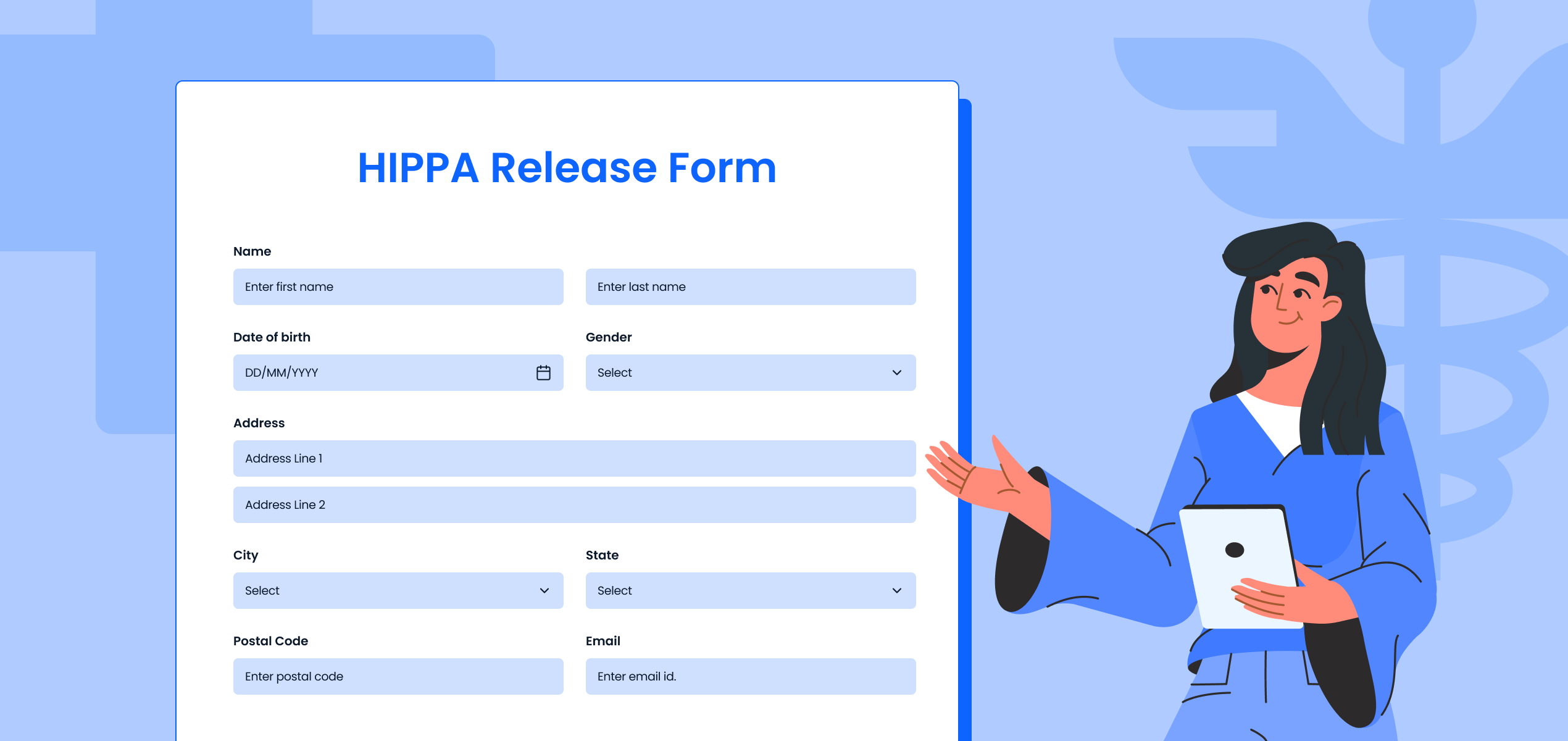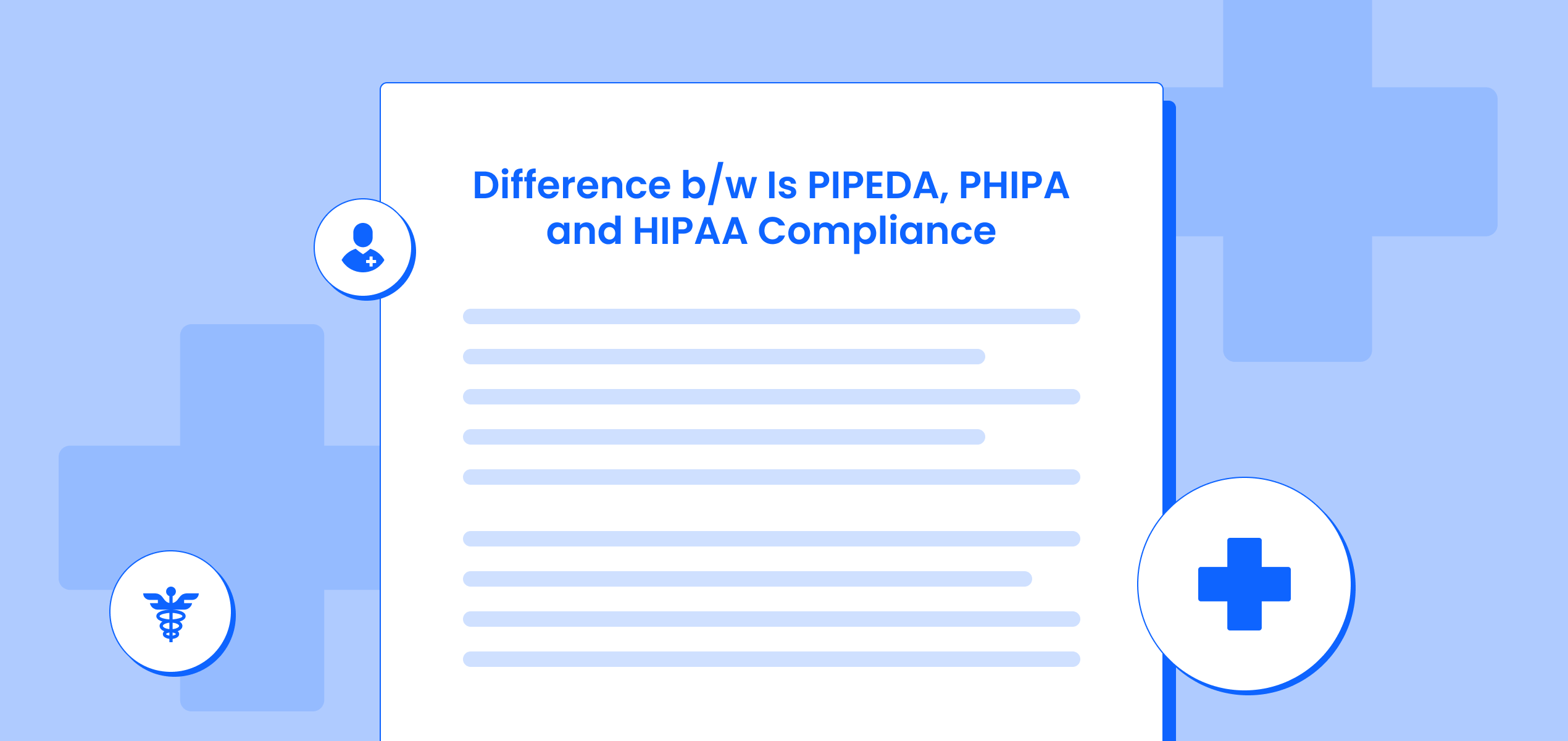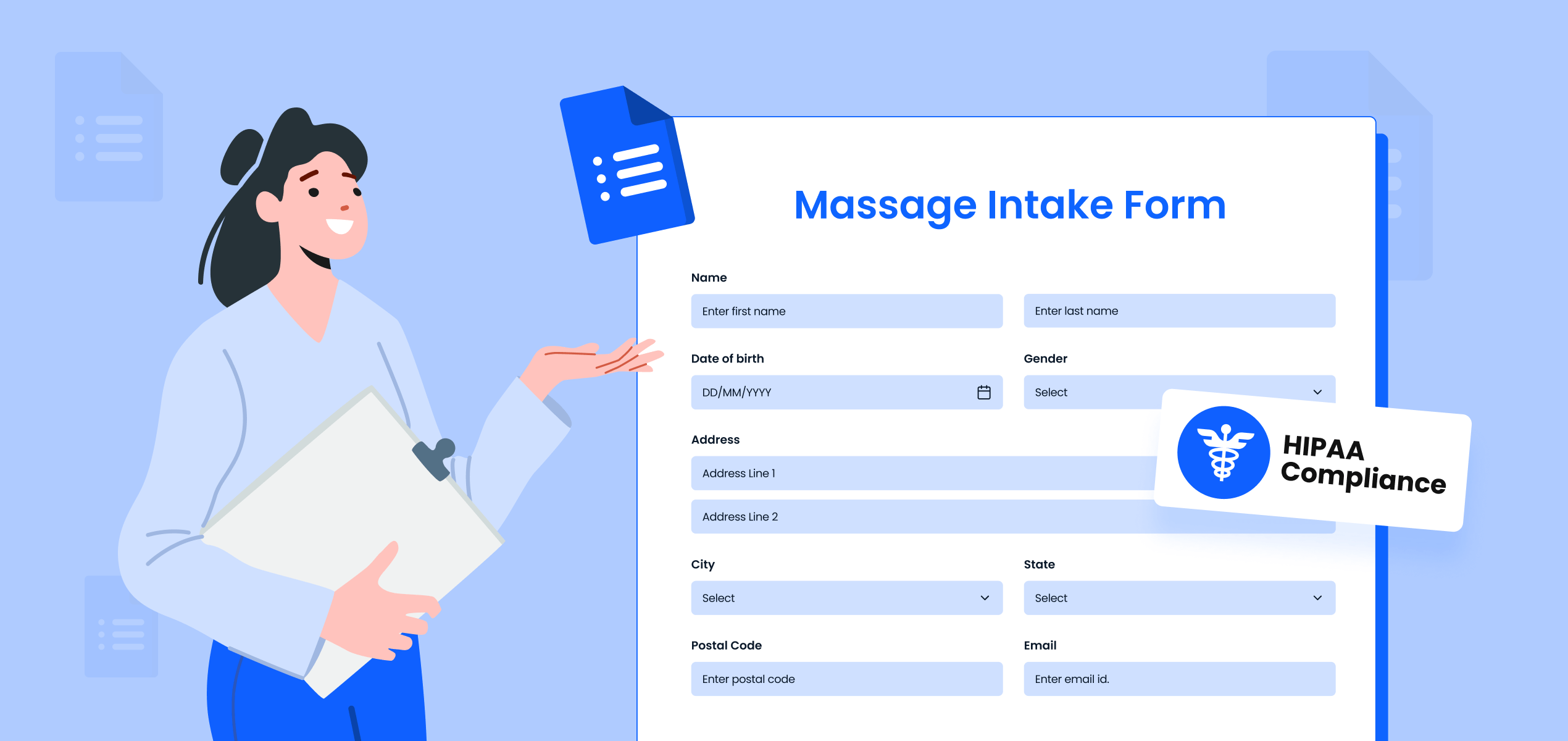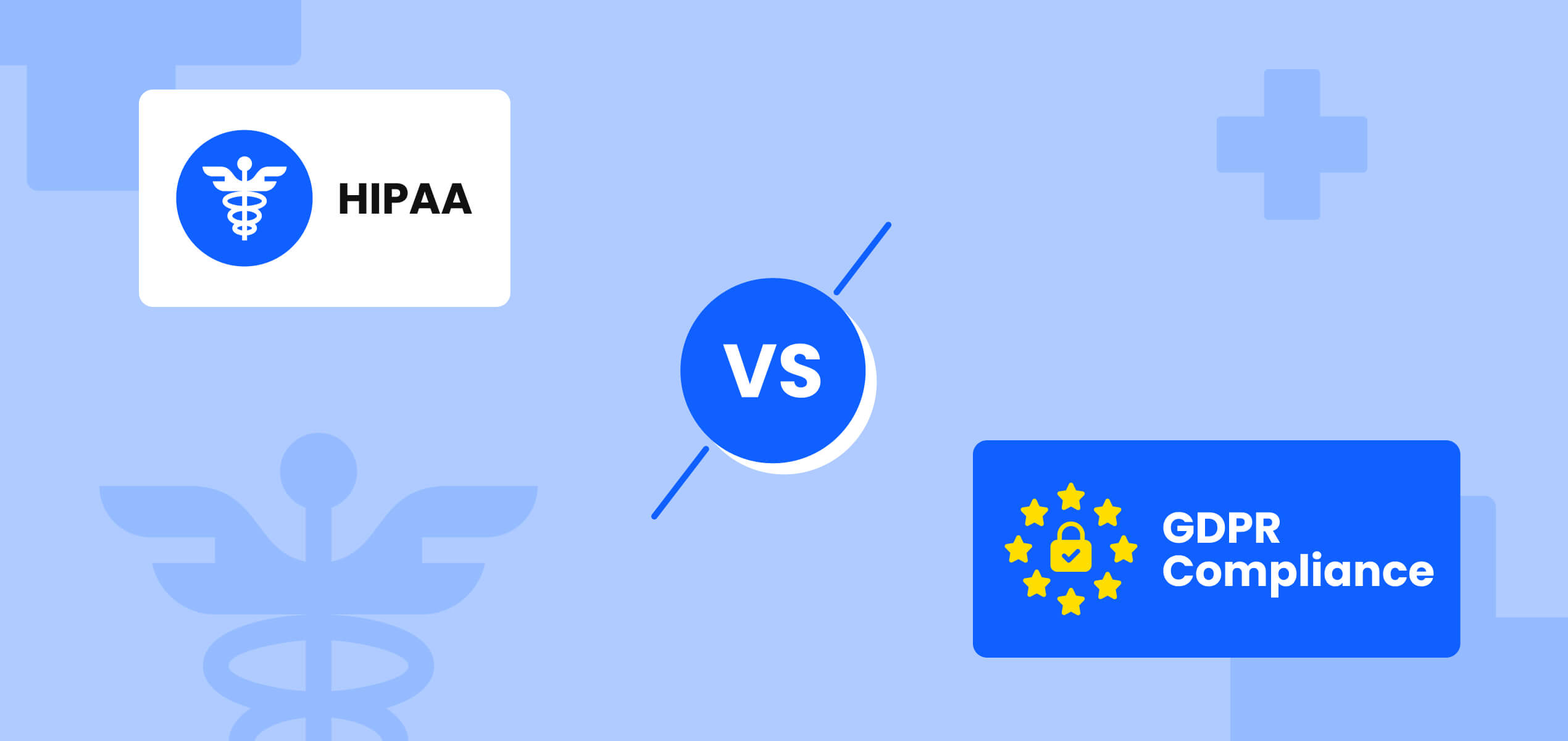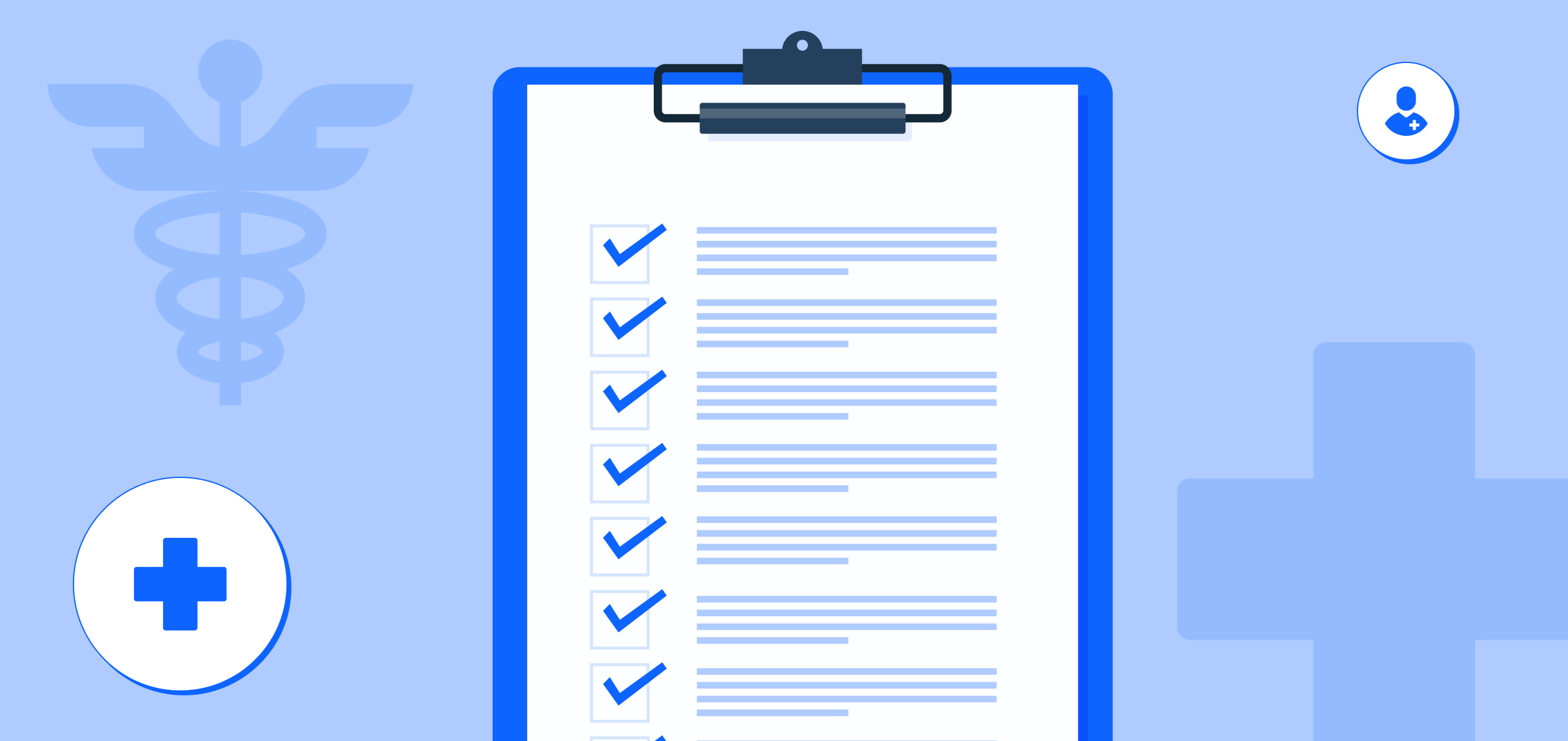Summary
- HIPAA Release Forms give patients control over their medical information by authorizing disclosure for specific purposes. They are also crucial for healthcare providers to comply with HIPAA regulations and avoid hefty fines.
- HIPAA Release or Authorization forms ensure your patients’ protected health information is shared securely. This builds trust and fosters a healthcare system focused on transparency and patient privacy.
- Online HIPAA Release/Authorization forms help secure and simplify the process for both patients and staff, translating to faster completion times, improved documentation, and overall workflow efficiency.
The digital age has indubitably helped streamline healthcare, but safeguarding patient privacy remains critical. HIPAA is a law that ensures national standards for protecting sensitive information.
In this blog, we focus on HIPAA Release Forms, a particular type of form that is a key tool to empowering patients to control their health information (PHI) and authorizing its disclosure for specific purposes. We explore the intricacies of using online HIPAA-compliant Release Forms effectively and integrating them into your clinic workflow with ease.
What Is The HIPAA Privacy Rule and How does it Benefit You and Your Patients?
HIPAA stands for Health Insurance Portability and Accountability Act, a federal law enacted in 1996. It applies to healthcare providers, health plans, and healthcare entities. It sets clear guidelines on how you handle patients’ protected health information (PHI).
Here’s how HIPAA benefits you and your patients:
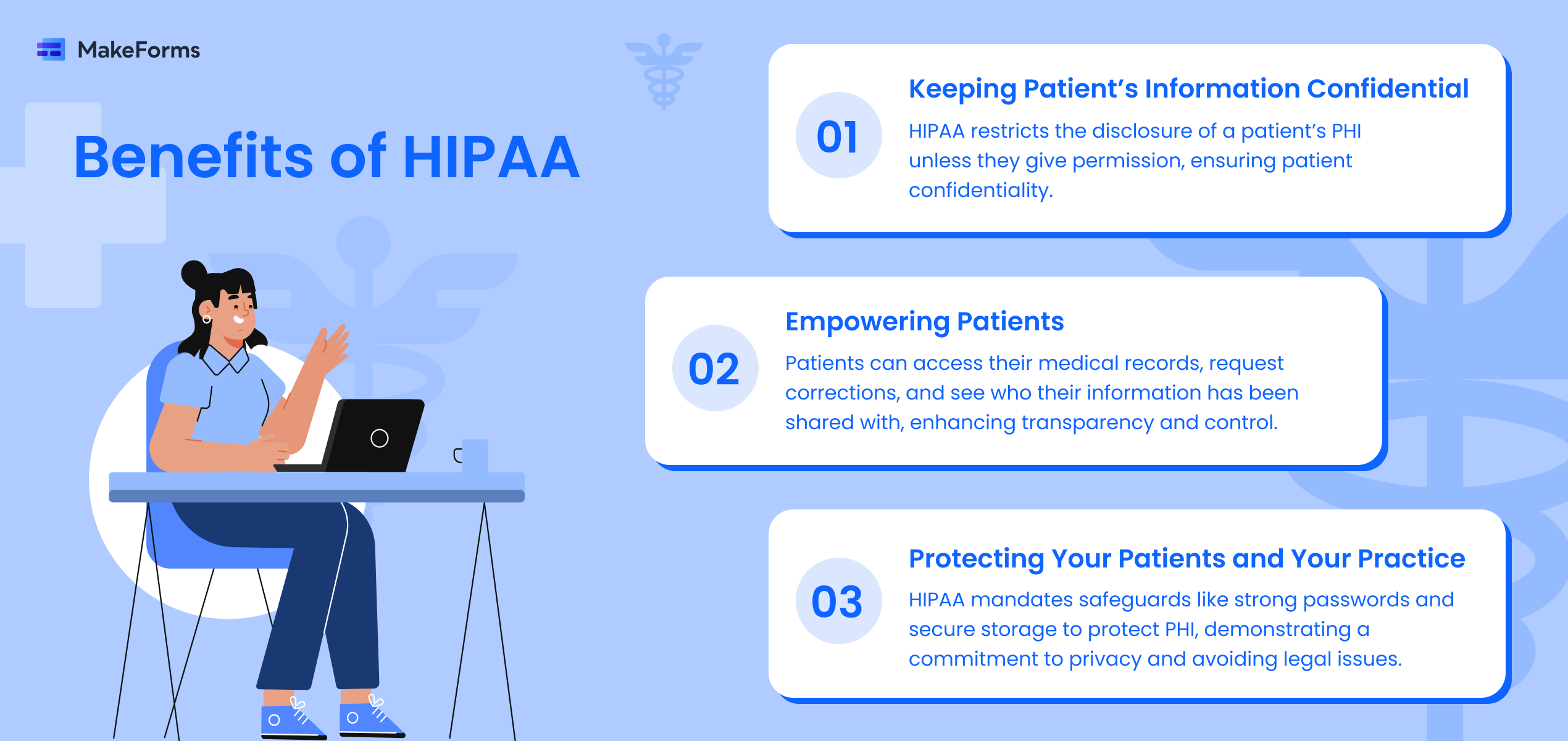
- Keeping Patient’s Information Confidential:
No one gets to peek into a patient’s medical records without their permission. HIPAA restricts the disclosure of a patient’s PHI unless they give the go-ahead. There are of course exceptions for emergencies or public health threats, but for the most part, HIPAA lays a strong foundation for patient confidentiality. - Empowering Patients:
Patients have the right to see their medical records, request corrections if something’s wrong, and even get a list of who their information has been shared with. This transparency builds trust and allows patients to take charge of their healthcare data. - Protecting Your Patients and Your Practice:
HIPAA mandates that you implement safeguards to protect your patients’ PHI. This includes using strong passwords, secure electronic storage systems, and restricting access to only authorized personnel. Following these guidelines shows your commitment to patient privacy and compliance with federal regulations. This avoids potential legal issues.
What Is A HIPAA Release Form / Authorization Form?
A HIPAA release form, also known as an authorization form, is a mandatory document for upholding HIPAA compliance within an organization. Its main purpose is to enable you to share specific parts of a patient’s PHI with designated individuals or organizations involved in their care, provided that the patient has given explicit consent.
A HIPAA Release Form or Authorization form clearly explains:
- What information will be shared: This could be their entire medical history or just specific details, like medications for a specialist consultation.
- Who will receive the information: This could be a specialist, a hospital admitting doctor, or a research group.
- The purpose of sharing the information: This could be for treatment, consultation, or research participation.
By signing a release form, your patient gives their informed consent for the controlled disclosure of their health data.
Types of HIPAA Authorization Forms
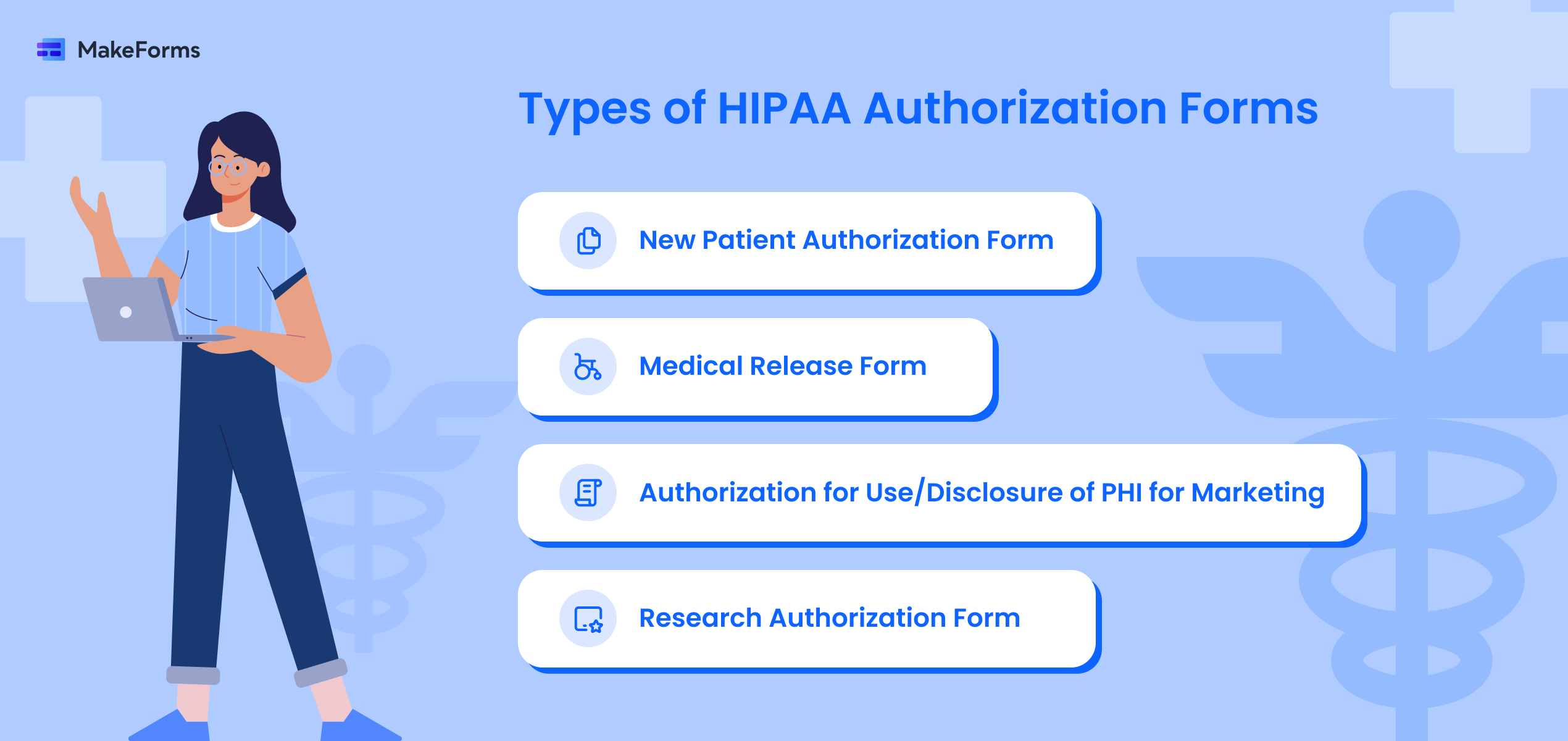
Let’s explore the various types of HIPAA authorization forms and their specific purposes in safeguarding patient confidentiality.
- New Patient Authorization Form
This form is used as a standard intake form to collect basic information about new patients, including demographics, insurance details, and communication preferences. It helps medical organizations verify patients’ insurance coverage and gather essential information for their records. - Medical Release Form
Medical release forms are crucial for maintaining patient confidentiality and are required before sharing medical information with anyone other than the patient, their healthcare providers, insurance companies, pharmacies, or legal representatives. They cover scenarios such as sharing PHI for research, disclosing psychotherapy notes, ongoing treatment by a departing physician, or marketing purposes. - Authorization for Use/Disclosure of PHI for Marketing
This form is necessary under HIPAA if a covered entity intends to use or disclose a patient’s protected health information for marketing activities. It must specify the exact PHI to be used, how it will be used in marketing communications, any financial remuneration involved, patient rights, and the option to revoke authorization. - Research Authorization Form
Researchers must obtain signed authorization from patients to access, disclose, or use PHI for research purposes. This form details the specific research study or protocol, how PHI will be used and disclosed, whether PHI is identifiable or de-identified, re-disclosure policies, and patient rights related to research participation.
Sample HIPAA Release Form (California)
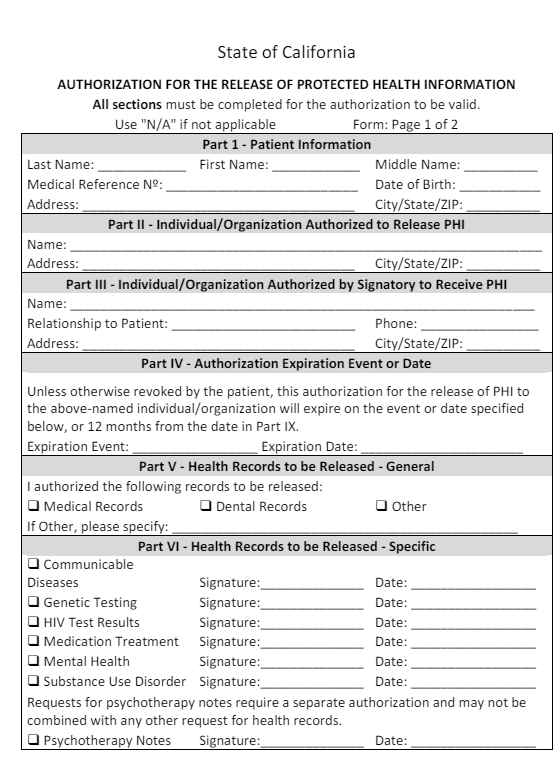
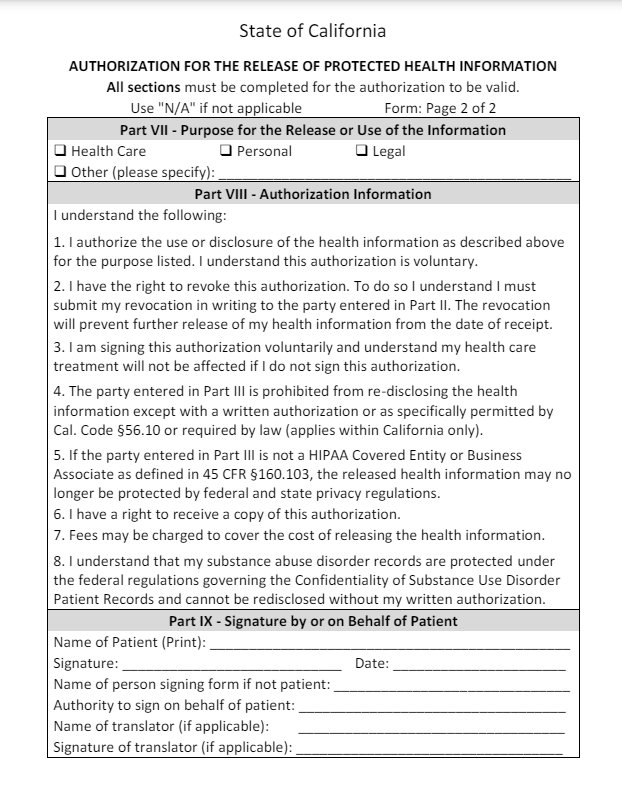
What’s Included In a typical HIPAA Release Form?
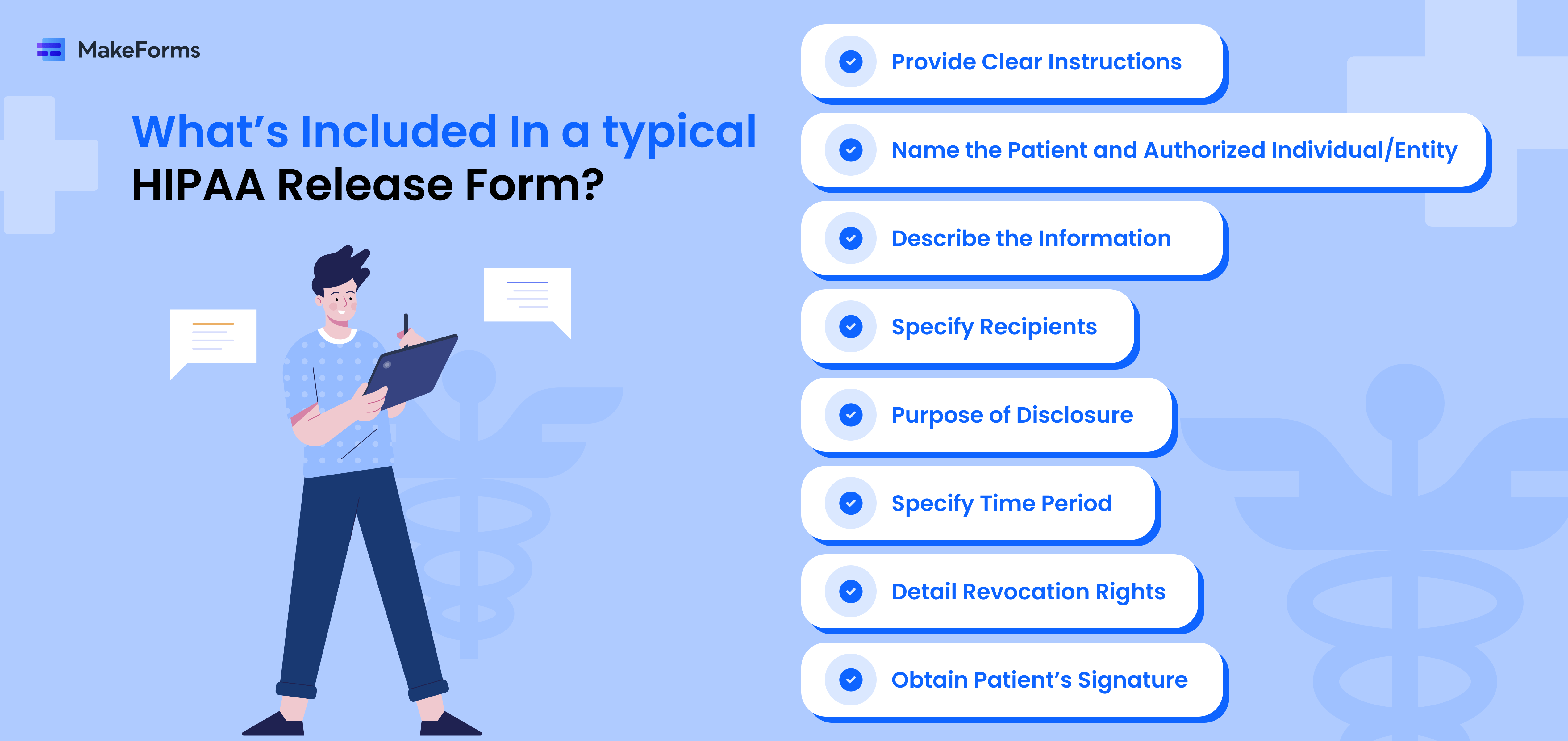
HIPAA release forms must be detailed, outlining the specifics of the information to be shared.
Here are the fundamental components to include:
1. Provide Clear Instructions: Always start by explaining the importance of accurate and complete information on the form.
Example: “Please fill out all sections accurately to ensure your health information can be shared as requested.
2. Name the Patient and Authorized Individual/Entity: Allow the patient to authorize who can access their PHI.
Example: “I, [Patient’s Name], hereby authorize [Name of Individual or Covered Entity] to share the information specified below with the person(s) or organization(s) I have identified in [Section No.] of this document.”
3. Describe the Information: Specify the types of information to be disclosed.
Example: “I authorize the mentioned individual or covered entity to:
- Share my complete health record.
- Share my complete health record, excluding the following information (please check any):
- Mental health records or psychotherapy notes.”
4. Specify Recipients: Identify who will receive the disclosed information.
Example: “I authorize the release of the health information described in this document to the following individual(s) or organization(s):
Name: ________________________________________________________________
Organization: ________________________________________________________________
Address: ________________________________________________________________”
5. Purpose of Disclosure: This is optional but you can allow the patient to state the purpose of the disclosure.
Example: “Purpose of request:
– My request
– Dispute
– Referral
– Other (please specify): _____________”
6. Specify Time Period: Define the validity period of the authorization.
Example: “This authorization is valid from [Start Date] to [End Date].”
7. Detail Revocation Rights: Inform patients of their right to revoke the authorization.
Example: “I acknowledge that I have the right to revoke this authorization for sharing my health data at any time, which I can do by submitting a written request to:
[Name]
[Organization]
[Address]
I understand that:
- If my information has already been shared before revocation, it may not be possible to cancel its sharing.
- No further permission is needed for the information specified in [Section No.] to be shared with the person(s) or organization(s) listed.
- Failing to sign or submit this authorization or revoking it will not affect my entitlement to receive treatment or benefits, unless sharing this information is necessary for eligibility or payment.”
8. Obtain Patient’s Signature: Provide space for the patient’s signature and date.
Why Are HIPAA Release Forms Important?
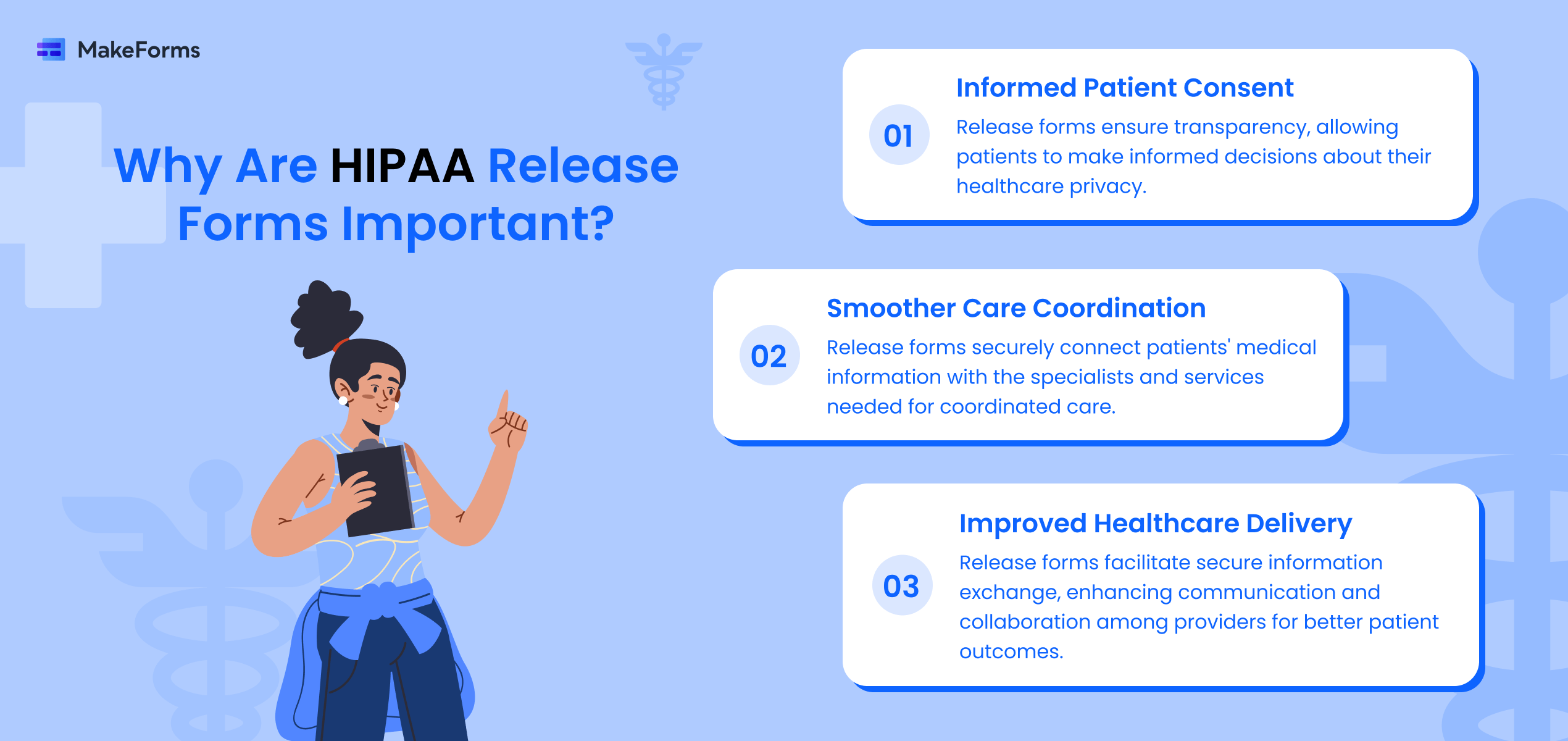
In situations where a patient needs a specialist’s expertise, a release form allows you to securely share relevant parts of their medical history, ensuring everyone has the full picture to create the best treatment plan. This is one of the main reasons why HIPAA release forms are essential, but there are more:
- Informed Patient Consent
Release forms ensure transparency. Patients can review exactly what information you plan to share and with whom. This empowers them to make informed decisions about their healthcare privacy. - Smoother Care Coordination
Release forms act as secure bridges connecting your patients’ medical information to the specialists and services they need. Sharing relevant medical history with a specialist or admitting doctor at another facility allows for a more coordinated care plan. - Improved Healthcare Delivery
Release forms enable secure information exchange between different healthcare systems. This fosters better communication and collaboration among providers, leading to more accurate diagnoses, effective treatment plans, and ultimately, better patient outcomes.
Plus, obtaining signed release forms demonstrates your commitment to HIPAA compliance and patient privacy. This protects your practice from potential legal issues and builds trust with your patients. It’s a win-win for everyone involved!
In What Situations Do You Use HIPAA Release Forms?
HIPAA Release Forms have a specific purpose, which means they are required to be used by particular entities in particular situations. Here’s who exactly needs to use them:
- Your Fellow Healthcare Providers
In situations when your patient needs to consult a specialist, a release form allows you to securely share relevant medical history, ensuring everyone has the full picture for optimal treatment. This applies to referrals (hospitals, home care), and consultations with other doctors. - Health Tech Helpers
Many doctors utilize health apps and software for patient records. If these tools store or share any medical data, a release form is crucial. It ensures patient privacy and HIPAA compliance. - Third-Party Partners
Do you work with external billing or lab services? A release form safeguards patient information when shared with these partners. It grants them access to only the necessary data. - International Associates
Collaborating with healthcare professionals abroad who might need access to patient data for treatment? HIPAA release forms ensure you comply with regulations even when working internationally. - Cloud Storage Solutions
Many practices rely on cloud storage for medical records. A release form helps confirm the cloud provider meets HIPAA compliance standards for data security. It verifies they have the proper safeguards in place. - Telemedicine Services
Offering virtual consultations? A release form empowers your patients and protects their privacy. It ensures they understand how their information is shared during these remote appointments.
By using HIPAA release forms for any situation where you share a patient’s medical information with someone outside your practice, you’re demonstrating your commitment to patient privacy and HIPAA compliance. - Pharmaceutical Companies
In some cases, pharmaceutical companies might require a release form to access specific patient data for research and development purposes related to new medications. - Insurance Companies
While some basic medical information might be shared with insurance companies for claims processing without a release form, obtaining a broader release form may be necessary if you need to disclose additional details beyond what’s standard for claims processing. - Marketing and Research
HIPAA protects patients from unwanted marketing or fundraising based on their medical history. Release forms are needed if you want to contact patients about specific products or research opportunities with their clear go-ahead. - Research Participation
Many patients choose to participate in medical research studies. Sharing information for these studies often involves a release form. This form explains exactly what information will be used (e.g., diagnosis, medications), why it’s important (e.g., to develop new treatments), and how privacy is protected (e.g., anonymization).
When are HIPAA Release Forms Not Required
Yes there are scenarios where a HIPAA Release Form is not MANDATORY but VOLUNTARY.
This applies to Covered entities, under the HIPAA Privacy Rule- they have the option to obtain patient consent voluntarily for uses and disclosures of protected health information (PHI) for treatment, payment, and healthcare operations.
Examples include healthcare providers like doctors, nurses, hospitals, and laboratory technicians using or disclosing PHI such as X-rays, laboratory reports, diagnoses, for treatment purposes.
What Happens If There’s A HIPAA Violation?
A HIPAA violation occurs when a covered entity (healthcare provider, health plan, or healthcare clearinghouse) impermissibly uses or discloses a patient’s PHI.
Here are some examples of HIPAA violations to avoid:
- Sharing a patient’s medical information without their authorization (except in permitted situations outlined in the Privacy Rule like above).
- Failing to implement appropriate safeguards to protect PHI, such as secure electronic storage and access controls.
- Selling a patient’s medical information to a third party without their consent.
HIPAA violations can have serious consequences, including significant fines and even criminal charges. Covered entities are responsible for ensuring they have appropriate policies and procedures in place to comply with HIPAA regulations and protect patient privacy.
HIPAA Release Form Checklist For Developers
As a developer working within a healthcare organization, you play a critical role in crafting user-friendly and compliant release forms. We’ve compiled a starter guide to kick you off because we know how complicated it can be to develop HIPAA compliant forms from scratch:
Building Trustworthy Forms:
- Make sure all necessary details are filled in by using automatic checks. This saves time and avoids errors.
- You need strong encryption.
- Make it accessible. Everyone should understand what they’re agreeing to. Make sure your forms are easy to read and work well with screen readers.
Keep Things Secure:
- Use multi-factor authentication (MFA). This adds an extra layer of security.
- Regular backups are essential.
- Allow patients to easily withdraw their permission to share information at any time.
Transparency Matters:
- Keep a clear and simple privacy policy. Explain how patient data is used in plain English, not legalese. Make it easy to find within the form itself.
- If your practice operates internationally, make sure your forms comply with local rules.
Keep it accessible
- Make forms available in different formats (paper or electronic) to accommodate patients with disabilities. This ensures everyone has equal access to information and control over their PHI.
Use multiple languages
- Consider offering forms in different languages to ensure everyone understands their rights and can make informed decisions.
Be Prepared:
- Have a plan in place to identify and respond quickly if a security issue arises.
Common Mistakes To Avoid When Developing A HIPAA Release Form
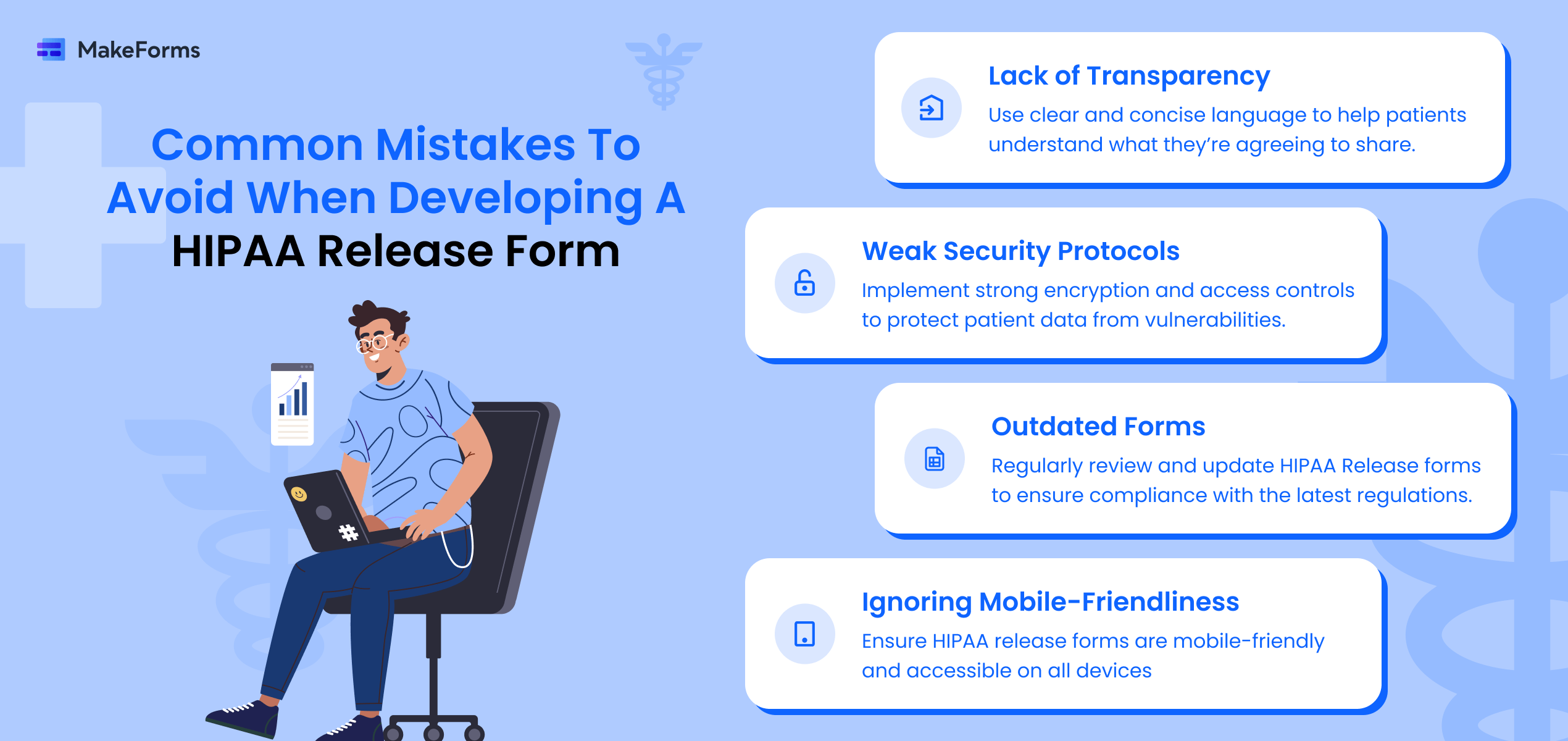
Sometimes, even the most well-intentioned practices can make mistakes. Here are some common pitfalls you can dodge:
- Lack of Transparency
While medical jargon is necessary, strive to strike a balance. Help the patient understand exactly what they’re agreeing to share in clear & concise language. - Weak Security Protocols
Strong encryption and access controls are like high-tech bodyguards for your patient data. Don’t leave it vulnerable with weak security measures. - Outdated Forms
HIPAA regulations evolve, and your forms need to keep pace! Regularly review and update your HIPAA Release forms to ensure they’re compliant with the latest rules. - Ignoring Mobile-Friendliness
These days, many patients access healthcare platforms on their phones. Make sure your HIPAA release form is mobile-friendly and works seamlessly on all devices.
Avoiding these common pitfalls with HIPAA release forms isn’t just about ticking boxes. It’s about building a foundation of trust with your patient and protecting both your patients and your practice.
Is it Easier to Just Use an Online Form Provider for HIPAA Release Forms?
So you’re ready to switch online HIPAA forms but confused about how to develop them, integrate them, execute them? Execution of online forms can make or break your workflow, leading to wasted time, frustration for patients and staff, and potential errors. If you’re thinking of simply signing on to a HIPAA compliant online form builder, then that’s a fantastic idea! Here’s how it can make your clinic or practice function SO much easier
- User-Friendly Forms: Online form providers already have customizable templates and tools to create user-friendly HIPAA release forms that align with HIPAA requirements.
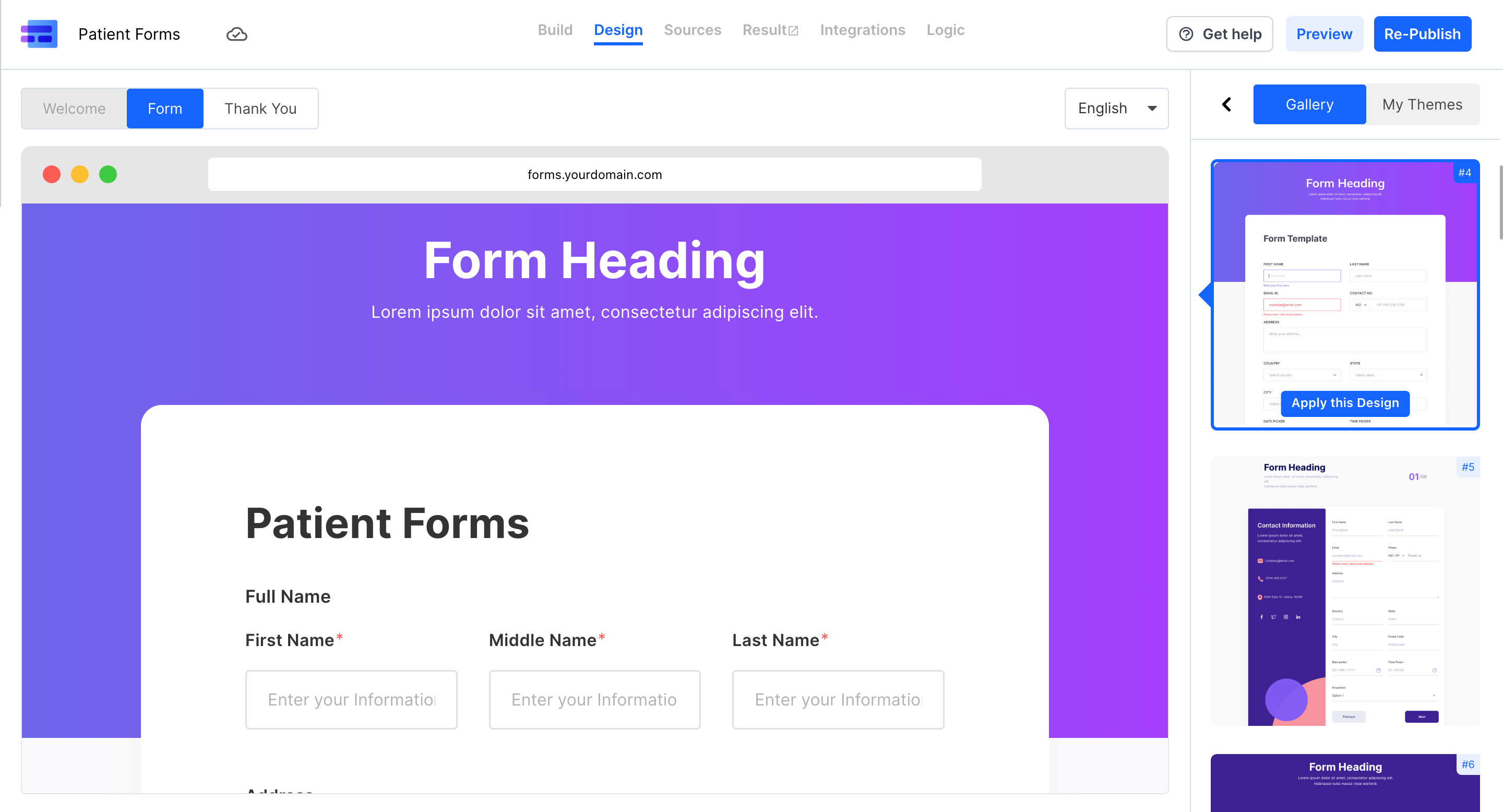
- Secure Digital Platforms: These providers generally offer secure platforms with encryption, access controls, and secure storage, ensuring that HIPAA release forms and PHI are stored and transmitted securely, maintaining patient privacy and data security.
- Electronic Signatures: Many providers include electronic signature solutions, allowing patients to sign forms electronically, streamlining the signing process and ensuring compliance with HIPAA standards for electronic signatures.
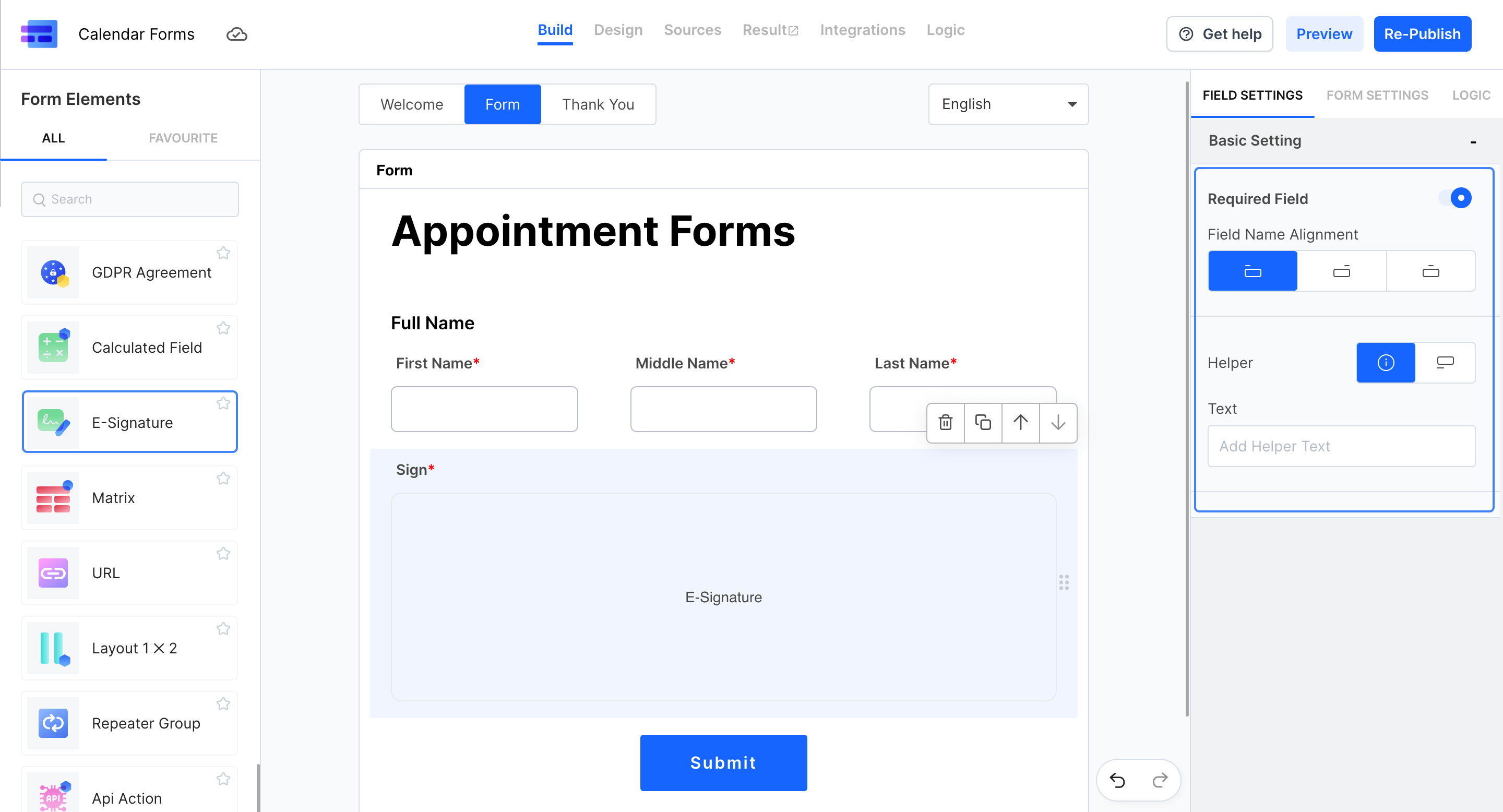
- Compliance Features: Reputable providers have built-in compliance features like HIPAA-compliant data handling practices, audit trails, and data retention policies, ensuring forms and data management practices remain compliant.
- Integration Capabilities: Some providers even offer integration with other systems like EHRs or practice management software.
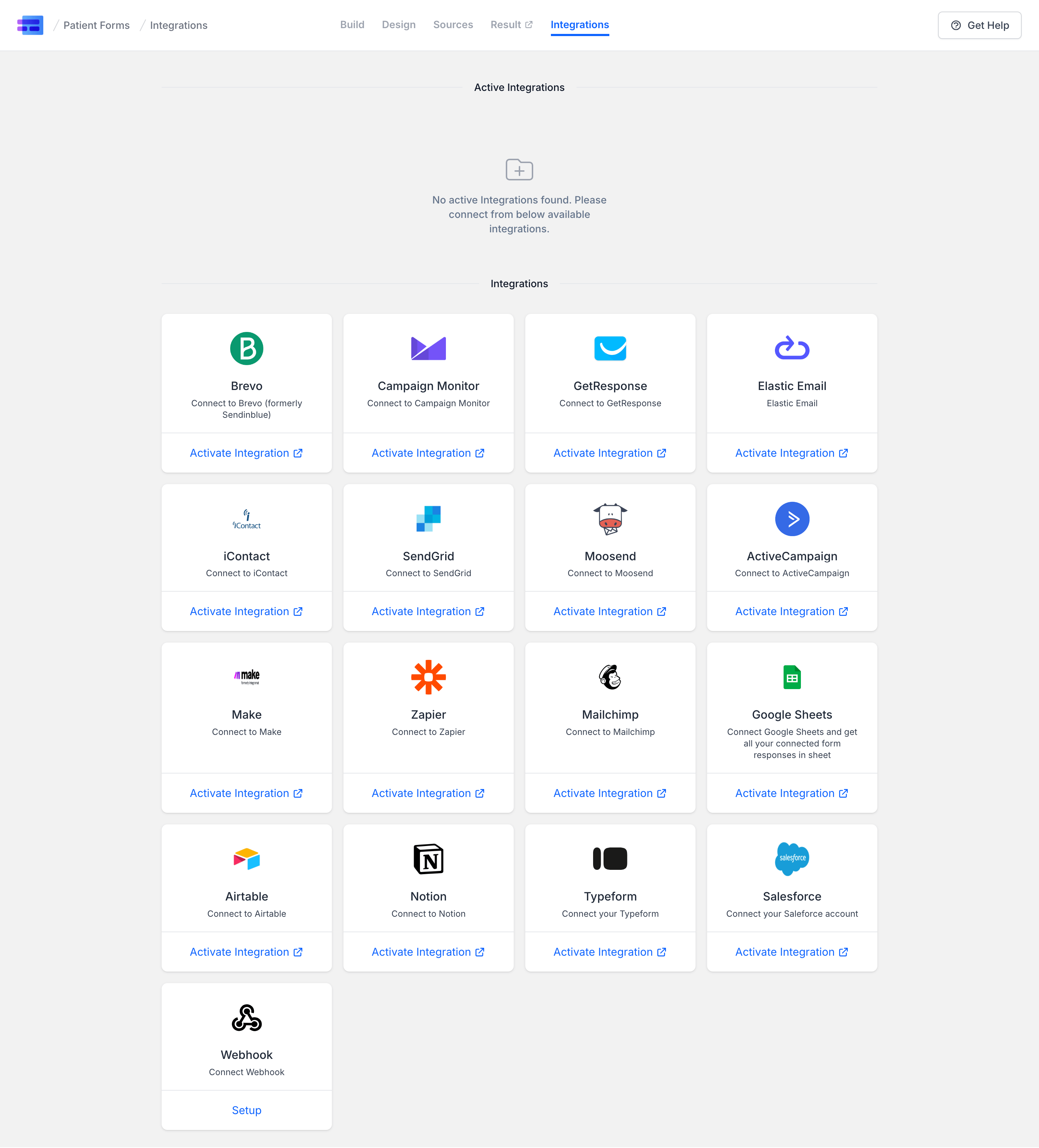
- Training and Support: They also offer training and support resources, providing guidance on best practices, compliance tips, and troubleshooting assistance.
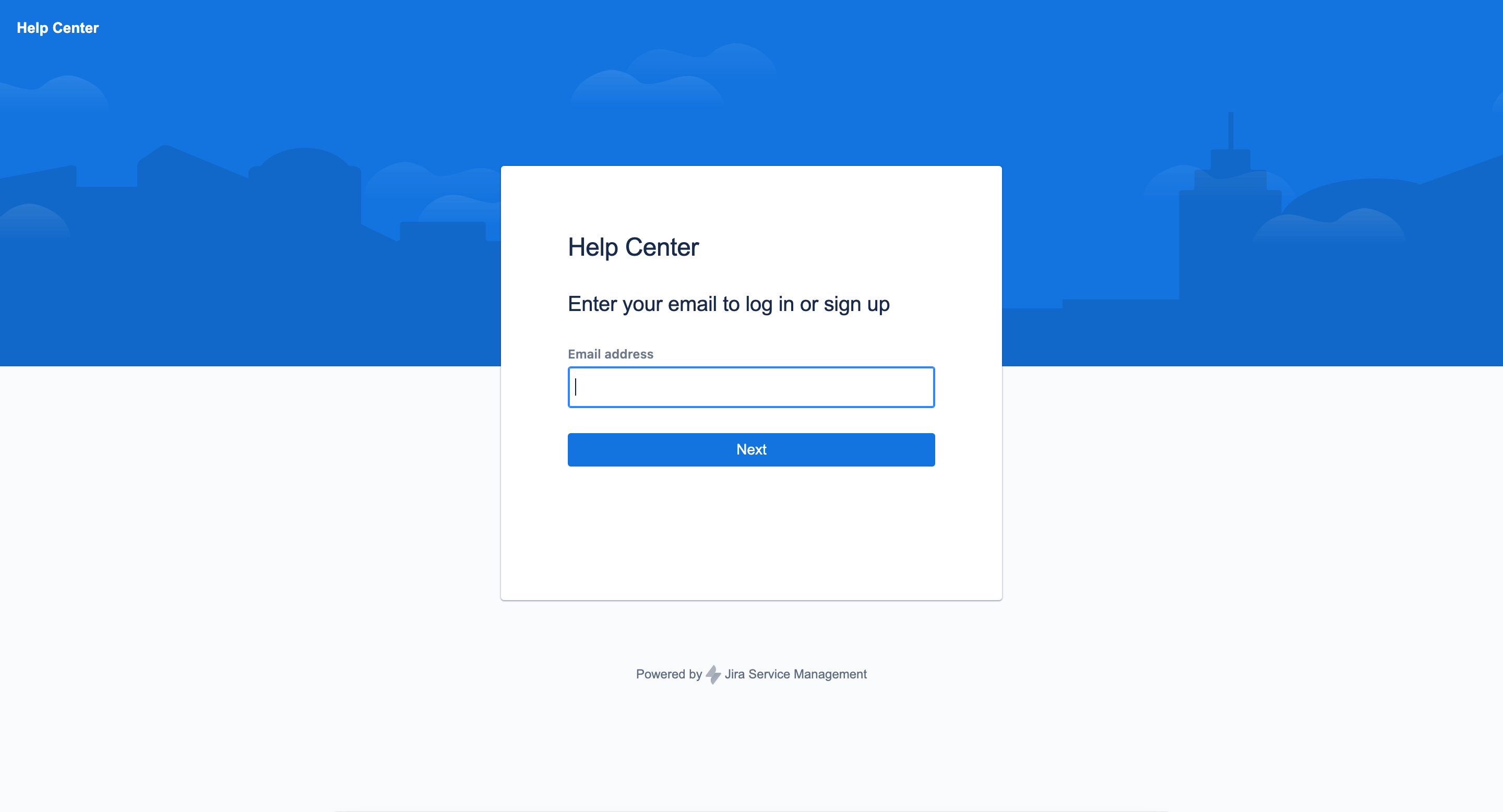
Make it Easy with MakeForms:
MakeForms integrates seamlessly with your existing systems, utilizes secure APIs, and offers a user-friendly platform to design customized workflows for HIPAA release forms. Experience the difference – streamline your processes and prioritize patient privacy with MakeForms.
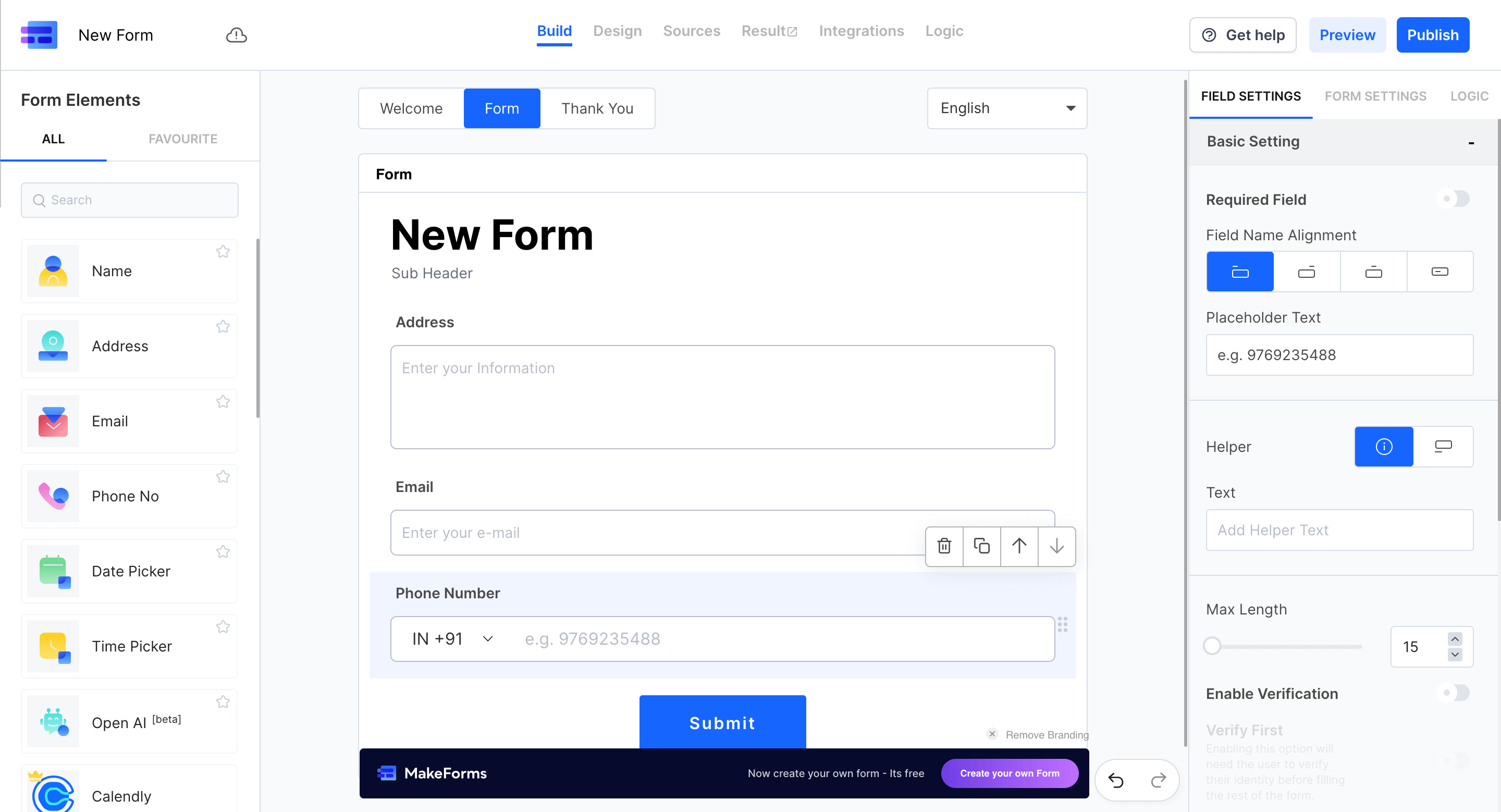
Here’s how we empower your healthcare practice:
- Simplifying HIPAA Compliance: MakeForms takes the complexity out of HIPAA compliance for release forms.
- Sky-rocket Patient Satisfaction: Patients appreciate a smooth and transparent process for managing their privacy preferences.
- Optimizing Care Coordination: Seamless information sharing, facilitated by MakeForms, streamlines communication and improves overall care coordination.
FAQs
A HIPAA Release Form is a document that allows patients to authorize the sharing of their protected health information (PHI) with specific individuals or organizations for specific purposes.
HIPAA Release Forms are important for several reasons:
- They ensure that patients have control over their PHI and can choose who their information is shared with.
- They help to protect patient privacy by ensuring that PHI is only shared for authorized purposes.
- They are required by law under the HIPAA Privacy Rule.
You need to use a HIPAA Release Form whenever you want to share a patient’s PHI with someone outside of their normal care team, such as:
- A specialist
- A research study
- A marketing campaign
- A third-party billing service
There are several different types of HIPAA Release Forms, such as a General Release Form, Limited Release Form, Research Release Form or even Marketing Release Form.
